The Clarkdale Review: Intel's Core i5 661, i3 540 & i3 530
by Anand Lal Shimpi on January 4, 2010 12:00 AM EST- Posted in
- CPUs
PAR2 Multithreaded Archive Recovery Performance
Par2 is an application used for reconstructing downloaded archives. It can generate parity data from a given archive and later use it to recover the archive
Chuchusoft took the source code of par2cmdline 0.4 and parallelized it using Intel’s Threading Building Blocks 2.1. The result is a version of par2cmdline that can spawn multiple threads to repair par2 archives. For this test we took a 708MB archive, corrupted nearly 60MB of it, and used the multithreaded par2cmdline to recover it. The scores reported are the repair and recover time in seconds.
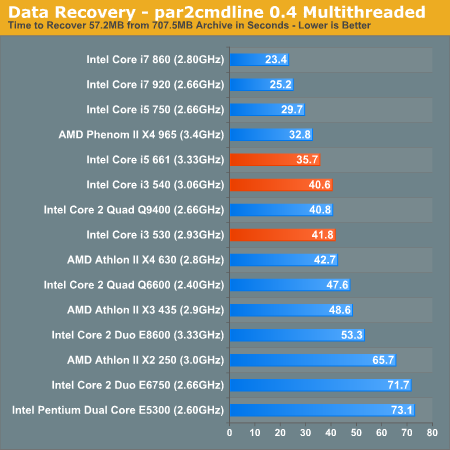
Our Par2 test gets a nice boost from more cores, making the i5 661 overpriced in this case. The i3s however do very well, outperforming the Athlon II X4 630 and the triple-core Athlon II 435.
WinRAR - Archive Creation
Our WinRAR test simply takes 300MB of files and compresses them into a single RAR archive using the application's default settings. We're not doing anything exotic here, just looking at the impact of CPU performance on creating an archive:
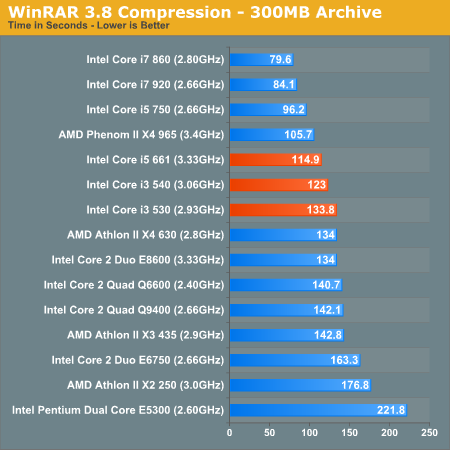
The lighter the desktop workload (as in the fewer stressful threads you have running) the better Clarkdale does. The Core i3s are particularly sensible here. It's basically Intel's answer to the Athlon II X4 600 series.
Microsoft Excel 2007
Excel can be a very powerful mathematical tool. In this benchmark we're running a Monte Carlo simulation on a very large spreadsheet of stock pricing data.
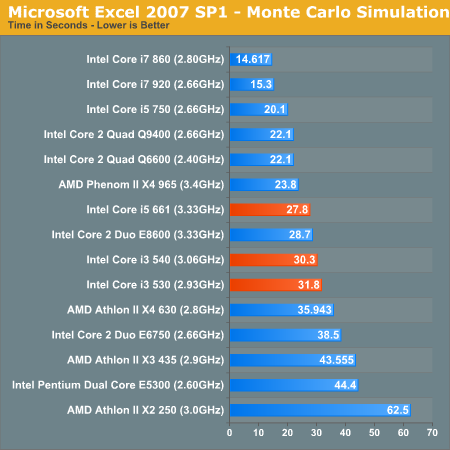
Intel believes that one of the biggest cases for Clarkdale in the business market is Excel performance. The Core i5 661 continues to be overpriced for what it is, but the i3 540 and 530 look very good here. They're can outperform the Athlon II X4 630 and draw less power. Nice.
Sony Vegas Pro 8: Blu-ray Disc Creation
Although technically a test simulating the creation of a Blu-ray disc, the majority of the time in our Sony Vegas Pro benchmark is spend encoding the 25Mbps MPEG-2 video stream and not actually creating the Blu-ray disc itself.
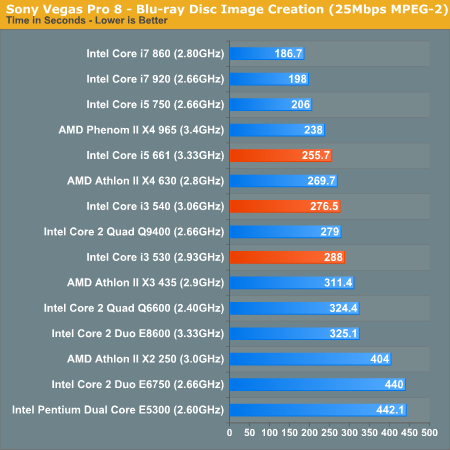
The i3s come pretty close to doing well in our Blu-ray creation test, but once again the i5 661 falls short thanks to its ridiculous price. The i3s are a reasonable alternative to the Athlon II X4 630.
Sorenson Squeeze: FLV Creation
Another video related benchmark, we're using Sorenson Squeeze to convert regular videos into Flash videos for use on websites.
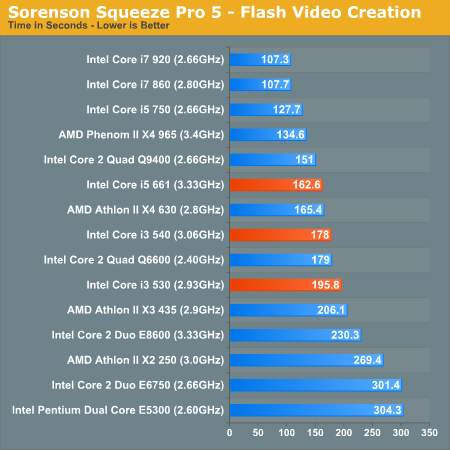
Clarkdale isn't a good choice for this test, with the 661 matching the Athlon II X4 630. The i3 parts place below AMD quad-cores but above the tri-core offerings.










93 Comments
View All Comments
Anand Lal Shimpi - Monday, January 4, 2010 - link
You're very right, it appears to be a side effect of the ASUS H57 board looking at everyone else's results. I'm out in Vegas at CES now but I'll run some numbers on Intel's H55 when I return this weekend.Take care,
Anand
plonk420 - Monday, January 4, 2010 - link
this power consumption is a bit weird... i've actually done the same testpc power & cooling 750 watt
i7-920, ex58-ud3r, 3x1 DDR3, hd5870, 2 hdds, 3 fans, HT on
default voltage: 215 watts in p95 (122 watts idle, no powersave mode)
undervolted 1.125v: 187 watts in p95 (121 watts idle, no powersave mode)
default, 8600GT: 211 watts in p95 (116 watts idle, no powersave mode), 184 watts on "sane load" (distributed computing)
1.125v, 8600GT: 183 watts in p95 (115 watts idle, no powersave mode), 164 watts on "sane load" (distributed computing)
i7-860, ex-p55m-ud2, 4x1 DDR3, 5870, 2 hdds, 2 fans, HT on
default voltage: (either i lost results, or i never tested them)
undervolted 1.025v: 167 watts p95 (107 watts idle, 101 watts in power saver), 149 watts on enigma@home (8 instances)
Spoelie - Monday, January 4, 2010 - link
The Load Power Consumption on page 4 also raises questions.The Phenom system rises 90w to decode a x264 movie, while the clarkdale system only rises 20w. It seems to me that the clarkdale system had DXVA support on while the Phenom system had it off..
Can someone check/confirm this?
Anand Lal Shimpi - Monday, January 4, 2010 - link
I was caught off guard by it too but DXVA was enabled. I'm currently out in Vegas for CES but when I return I'll give it another look in our Core i3 review. I've had issues with power consumption being stuck at unusually high levels on AMD boards in the past, but I couldn't get this one to shake in time.Take care,
Anand
MrAwax - Monday, January 4, 2010 - link
HD Codec bitstreaming has been added in HDMI 1.3 specs at the receiver manufacturer request for no reason except that they did want to lose their market.Since HD codecs are LOSSLESS, decoding them in the player or in the receiver makes NO difference. And HDMI supports streaming of 8 uncompressed channels in LPCM @192kHz/24b since 1.0. So digitally, there is ZERO POINT ZERO difference. This is the reason it is useless. And this is the reason HDMI added 8 channels of high resolution audio so you won't need to upgrade your receiver !
And this is stupid because bitstreaming is a LIMITATION of feature, not an added feature. BluRay norm supports in player audio mixing. A lot of discs are already supporting it. The player can mix sounds live on the main soundtrack. This is useful for adding dynamic menu sounds or director/actor commentary. In theory, the disc could even have a single music/fx soundtrack and dynamically mix voice to support multiple langage and save space on disc (voice is generally stereo, is not always present and reencoding every time the music/fx is a waste of storage). With HDMI bitstreaming, you can stream the main track only. Gone is the menu fx sound, gone is the bonus commentary and gone is the voice.
Welcome to receiver manufacturer lobbying for USELESS and STUPID feature.
PS: on the contrary, 8 channels hires LPCM is a great feature.
salacious - Monday, January 4, 2010 - link
Bitstreaming does have the disadvantages of loosing audio track mixing but it does offer something.If the decoding is done in the PC were are relying it to not to downsample to 48kHz/16bit which happens unless you have the correct combination of player and audio card. If the decoding is done in the PC you are relying that it decodes to the correct speaker and I have found that with a 7.1 speaker setups this is a complete mess.
Also if you want to apply any receiver effects to the audio then over HDMI you tend to be limited. If the movie is 5.1 and it is EX encoded and you have a 6.1/7.1 speaker setup, then the usual solution is to apply this processing in the receiver but if you set your PC to 7.1 then it sends 2 blank audio channels and you can't apply EX processing. You have the same problem is you play back a surround encoded stereo track on a 5.1 speaker system, all that happens is that the audio is output from the left/right speakers and you are unable to apply pro-logic decoding to it.
A solution would be for the PC to offer Pro-logic IIx and other types of decoding but as they don't then you need the receivers to do it which means bitsreaming.
FlyTexas - Monday, January 4, 2010 - link
...Is this really needed?Ok, so more speed is good, I wouldn't turn it down... ...however anyone who uses computers in the office environment knows that CPUs have been "fast enough" for awhile now.
We currently have a dozen Dell Vostro 200's with Pentium Dual Core 1.6ghz CPUs, and a dozen Dell Vostro 220's with Pentium Dual Core 2.4ghz CPUs in the office (among a few other oddball machines and the server).
These computers run Office 2007, Adobe Acrobat 9, IE 8, etc. Some of them also run Quickbooks and a few other programs. None are used for video encoding, games, or anything that fancy.
You know what? The difference between the 1.6ghz machines and the 2.4ghz machines isn't all that noticeable, once everything is up and running (they all have 2GB of RAM, running Windows XP Pro SP3). They all have the Intel GMA graphics, and for the office, they are all plenty fast.
Why would our company upgrade to these new CPUs?
The Pentium Dual Core CPUs were a nice jump over the Pentium 4 line. (we used to have all Pentium 4 machines back in 2006) This new line of CPUs doesn't seem like the same kind of improvement.
tomaccogoats - Monday, January 4, 2010 - link
I only look at new cpu's for gaming :plowlight - Monday, January 4, 2010 - link
You might notice a difference if they were running Windows 7 with 4GB of ram. Right now they are all a bit bottlenecked by the OS (poor multitasking performance) and low amount of RAM.But in general I agree with what you're saying.
FlyTexas - Monday, January 4, 2010 - link
I have Windows 7 installed on my computers at home, I haven't moved the office machines due to a lack of any good reason to do so.We have Windows 2003 R2 Small Business Server at work. Everyone is on user accounts on a domain. We have a hardware firewall running as well as the usual antivirus/spam/etc. stuff running.
It all just works, I have no desire to rip it all apart, spend a lot of the company's money, to gain... well I'm not sure what we'd gain. If I can't think of a good reason to do it, I sure can't sell it to the boss.
This isn't a knock against Microsoft, I personally love Windows 7, it is great for my home computer, but it doesn't do anything for the work computers. In a larger company, I can see the benefits of moving to it (and Server 2008), but we just don't have that large of a network (or budget).
As a side note: You wouldn't have wanted to see the mess that was here when I got here, it was all running on a wireless linksys router on an unencrypted network. I managed to get the office wired with gigabit ethernet and turn off the wireless. Got a good server in place, setup a Dell account, and moved out most of the oddball machines (we did two lease purchases of machines, one for each dozen of the Vostros, got a heck of a deal on them too). Of course I sold this to the boss by saying that it would all last at least 5 years, and we're about 2 years into that 5 year plan. :)
Maybe we'll just skip Windows 7 and move to 8 when it comes out.